The article describes some of the most dangerous chemical poisons and their effect on human body. We wish you never to come into contact with these substances. Poison is a substance that, even in small doses, leads to a detrimental effect on the body: poisoning, illness and death. Poisons are usually depicted with the sign of a skull and crossbones. Chemical poisons are produced by synthesizing various substances.
Acrolein
It is a colorless, highly toxic liquid with a tear effect and is highly volatile. The substance was used in the First Pestilence War as a chemical weapon. Acrolein, when inhaled, is highly irritating to the mucous membrane and respiratory tract. It is synthesized during the thermal decomposition of glycerol.
Soman- colorless combat liquid with the smell of apples. It has a nerve paralytic property, the first symptoms are noticeable minutes after the lesion - the pupils dilate, breathing becomes difficult. First used in 1944.
Carbon disulfide

Carbon disulfide is a liquid with a pleasant odor, but extremely poisonous. A lethal dose of 1 gram has a narcotic effect. Symptoms: loss of consciousness, convulsions, severe headache. Also vomiting, intermittent breathing, chemical burns (skin contact).
Trimethylamine- The gas is colorless and has the odor of ammonia. Low concentrations of the gas cause eye irritation and irritation of the mucous membrane of the respiratory tract. At higher concentrations it suffocates.
Phosgene– a colorless toxic gas with the smell of hay. Poisonous if vapors are inhaled, the first symptoms appear after 4-8 hours. Inhaling the gas for 60-90 minutes is not poisonous, but sensitive people may experience mild poisoning. Inhaling one milligram per liter for 5 minutes leads to a 70% death rate.
Phosgene affects taste buds and on the olfactory nerve, after which a person’s sense of smell becomes dull. Symptoms: pulmonary edema, but at particularly high concentrations it does not occur; at high concentrations a person inhales the gas, falls sharply to the ground, convulsions begin and the face turns dark blue, death quickly occurs. Due to the volatility of phosgene, it was used as a military weapon.
Chlorine– a simple gas, yellowish in color, has a metallic taste. Chlorine is used in industry, science and everyday life; it was used by Germany in the First world war in 1915 If it enters the lungs, it causes burns to lung tissue; in higher concentrations it causes suffocation.
Potassium cyanide

Potassium cyanide is a colorless crystal, similar to sugar with the smell of almonds. A very powerful poison; if it enters the gastrointestinal tract, the lethal dose for an adult is 1 mg/kg. Causes convulsions, difficulty breathing and death within minutes.
Strychnine– white, odorless powder. For poisoning, a small amount is enough; the poison can be ingested by breathing, touching or eating. Causes seizures, difficulty breathing, and brain death approximately 30 minutes after injury.
The video shows dangerous animal poisons, their symptoms and effects on the human body.
Hydrogen is a colorless, odorless and tasteless gas, slightly soluble in water.
Chlorine is a poisonous gas of yellow-green color with a pungent odor. Slight solubility in water.
Hydrogen chloride is a colorless gas with a pungent odor, highly soluble in water, and fumes in air.
Fluorine is a poisonous light green gas.
Bromine is a heavy red-brown liquid.
Iodine is a black-violet solid.
Oxygen is a colorless, tasteless and odorless gas, slightly soluble in water.
Sulfur is a solid, brittle, yellow substance, insoluble in water, and a poor conductor of heat and electricity.
Hydrogen sulfide is a very poisonous gas with the smell of rotten eggs and is highly soluble in water.
Sulfuric acid is a heavy, colorless, oily liquid, non-volatile, odorless, anhydrous and does not conduct electricity.
Nitrogen is a tasteless and odorless gas; its solubility in water is less than that of oxygen.
Ammonia is a colorless gas with a characteristic pungent odor, highly soluble in water.
Nitric oxide (2) is a colorless gas, poorly soluble in water.
Nitric oxide (4) is a brown gas with a specific odor, poisonous, dimerizes to form a colorless liquid.
Nitric acid is a colorless liquid with a pungent odor, smokes, and mixes with water in any ratio.
White phosphorus is a colorless, very toxic substance that does not dissolve in water.
Red phosphorus is a red-brown powder, non-toxic, insoluble in water.
Black phosphorus - similar to graphite, greasy to the touch.
Phosphorus oxide (5) is a white hygroscopic powder.
Phosphoric acid is a white solid that can be mixed with water in any proportion.
Diamond is a colorless crystalline substance with an atomic lattice.
Graphite is a dark gray substance with a weak metallic luster, greasy to the touch.
Carbin is a finely crystalline black powder.
Carbon monoxide (2) is a colorless and odorless gas, extremely poisonous.
Silicon is a dark gray substance with a steely sheen and is fragile.
Silica is a solid, refractory substance.
Silicic acid is weak and slightly soluble in water.
Sodium and potassium are silvery-white metals that can be cut with a knife.
Sodium and potassium hydroxides are white, opaque, crystalline solids.
Calcium is a silvery-white, hard, lightweight metal.
Calcium oxide powder white.
Calcium hydroxide is a white solid, slightly soluble in water.
Aluminum oxide (alumina) is a refractory, white solid.
Chrome is a grayish-white shiny metal.
Chromium hydroxide (3) - gray-green.
Chromium oxide (3) is a green powder.
Chromates are colored yellow, and dichromats - orange.
Iron oxide (2) is a black, easily oxidized powder.
Iron hydroxide (2) is a white precipitate, (3) is red-brown.
Methane is a colorless and odorless gas, slightly soluble in water.
Ethylene is a colorless gas with a faint sweetish odor and is slightly soluble in water.
Acetylene is a colorless gas, slightly soluble in water, with a weak narcotic effect.
Styrene is a colorless liquid with a pleasant odor.
Benzene is a colorless, volatile, flammable liquid with a peculiar odor; it is insoluble in water. Poisonous.
Hexachlorane is a colorless crystalline substance.
Nitrobenzene is an oily, pale yellow liquid with the odor of bitter almonds, insoluble in water.
Cyclohexane is a colorless volatile liquid with the smell of gasoline; it is insoluble in water.
Methanol is a colorless liquid and a strong poison.
Ethylene glycol is a syrupy liquid with a sweet taste, odorless, toxic, mixes well with water, and is hygroscopic.
Glycerin is a colorless, viscous, hygroscopic liquid, sweet in taste, miscible with water in any ratio.
Nitroglycerin is a heavy oily liquid, explosive.
Phenol is a colorless crystalline substance with a sharp characteristic odor, turns pink in air, is poorly soluble in water, and is poisonous.
Picric acid is a yellow crystalline substance with a bitter taste and is poisonous.
Formaldehyde is a colorless gas with a pungent, suffocating odor and is poisonous.
Acetone is a colorless, flammable liquid with a characteristic odor, highly soluble in water.
Aniline is a colorless oily liquid with a weak characteristic odor, slightly soluble in water, poisonous, and acquires a red-brown color when exposed to air.
Methylamine smells like ammonia.
Amino acids are colorless crystalline substances, highly soluble in water.
Formic acid amide is liquid.
Amides of other acids are white crystalline substances.
Pyrrole is a colorless liquid with the odor of chloroform, slightly soluble in water, quickly darkens in air, and acidophobic.
Furan is a colorless, low-boiling liquid, acidophobic.
Thiophene - resembles benzene, a colorless, low-boiling liquid with the odor of benzene, insoluble in water.
Imidazole is a crystalline substance, highly soluble in water and ethanol.
Pyridine is a colorless liquid with an unpleasant odor, miscible with water in any ratio.
Esters are clear liquids, often with a pleasant fruity odor. They are neutral and very stable, but can hydrolyze when heated in the presence of strong acids or bases. They are less polar than the same alcohol as a solvent. Esters have extremely good solubility for polar substances; With increasing length of the carbon chain in alcohol and acid groups, solubility with respect to polar products decreases, but increases with respect to less polar substances. Lower esters are partially soluble in water. The most important solvents in the group of esters for the paint and varnish industry are acetates. Formates are used to a lesser extent because they have a stronger effect on living organisms and are more easily hydrolyzed. Propionates, butyrates and isobutyrates are less important as they have a strong fruity odor. Also great importance have some esters of glycolic and lactic acids, as well as dimethyl esters of mixtures of dicarboxylic acids.
Methyl formate is a colorless, water-soluble liquid. It dissolves nitrocellulose, cellulose acetate, oils and fatty acids. Ethyl formate - partially miscible with water. It dissolves nitrocellulose, cellulose acetate and many resins. Butyl formate - slightly soluble in water. It dissolves nitrocellulose, fats, oils, many polymers and chlorinated rubber. However, it does not dissolve cellulose acetate. Isobutyl formate has solvent properties similar to butyl formate. It is part of commercially produced paint solvents. Methyl acetate is partially miscible with water and mixes easily with many organic solvents. For example, with vinegar essence, everyone knows where to buy it. It dissolves well cellulose esters and ethers, rosin, polyurea, melamine and phenol-formaldehyde resins, polyvinyl acetate, alkyd, ketone and other resins. It will not dissolve shellac, dammar resin, copal or polyvinyl chloride. Methyl acetate is used as a highly volatile solvent to reduce the viscosity of paints (alone or mixed with alcohols or other esters), as a substitute for acetone in adhesives and as a softener (plasticizer) for hard shoe uppers in the footwear industry.
Ethyl acetate is a colorless neutral liquid that has limited miscibility with water and has a pleasant fruity odor. It has good dissolving ability towards nitrocellulose, cellulose ethers, chlorinated rubber, polyvinyl acetate, vinyl chloride copolymers, polyacrylates, polystyrene, fats, oils, many natural and synthetic resins (alkyd, saturated polyester, ketone resins). However, cellulose acetate is only soluble in the presence of small amounts of ethanol. Does not dissolve polyvinyl chloride. Ethyl acetates are very important chemical solvents for fast-drying paints (such as nitrocellulose-based wood paints).
Diethyl acetal(CH 3 ·CH·(OC 2 H 5) 2). It is also a derivative of the hypothetical acetaldehyde hydrate. Colorless liquid with a pleasant odor, similar to the smell of ether; used as a solvent and as an anesthetic.
To this product item don't turn on polyvinyl acetals ( commodity item 39.05).
(B) Halogenated, sulphonated, nitrated or nitrosated derivatives of acetals and hemiacetals
These derivatives are compounds obtained by completely or partially replacing one or more hydrogen atoms in the acetal with halogens (eg, chloral alkoxide, chloropropylacetal), sulfo groups (-SO 3 H), nitro groups (-NO 2) or nitroso groups (-NO).
The heading also covers any combination of these derivatives (for example, nitrohalogenated, nitrosulphonated, sulfohalogenated and nitrosulfohalogenated derivatives).
Subgroup V
COMPOUNDS WITH ALDEHYDE FUNCTIONAL GROUP
|
29.12 - |
Aldehydes, whether or not containing another oxygen-containing functional group; cyclic aldehyde polymers; paraformaldehyde: |
|
|
– acyclic aldehydes that do not contain another oxygen-containing functional group: |
||
|
2912.11 |
– – methanal (formaldehyde) |
|
|
2912.12 |
– – ethanal (acetaldehyde) |
|
|
2912.19 |
- - other |
|
|
– cyclic aldehydes that do not contain another oxygen-containing functional group: |
||
|
2912.21 |
– – benzaldehyde |
|
|
2912.29 |
- - other |
|
|
– aldehyde alcohols, ether aldehydes, aldehyde phenols and aldehydes containing another oxygen-containing functional group: |
||
|
2912.41 |
– – vanillin (4-hydroxy-3-methoxybenzaldehyde) |
|
|
2912.42 |
– – ethyl vanillin (3-ethoxy-4-hydroxybenzaldehyde) |
|
|
2912.49 |
- - other |
|
|
2912.50 |
– cyclic aldehyde polymers |
|
|
2912.60 |
– paraformaldehyde |
|
These compounds are formed by the oxidation of primary alcohols; they contain a characteristic group:
The compounds are usually colorless liquids with a strong, pungent odor; many aromatic aldehydes are easily oxidized in air, turning into acids.
The term "aldehydes with another oxygen-containing functional group" means aldehydes that also contain one or more oxygen-containing functional groups that are mentioned in the previous subgroups (alcohol, phenolic, ether, etc. functional groups).
(A) Aldehydes
Saturated acyclic aldehydes.
Methanal(formaldehyde) (H·CHO). Obtained by catalytic oxidation of methanol. A colorless gas with a pungent odor, highly soluble in water. Its aqueous solutions with a concentration of about 40%, known as formalin or formol, are colorless liquids with a pungent and suffocating odor. These solutions may contain methanol as a stabilizer.
Ethanal(acetaldehyde) (CH 3 ·CHO). Obtained by oxidation of ethanol or from acetylene. Mobile colorless liquid with a pungent, fruity odor; caustic; very volatile, flammable; miscible with water, alcohol and ether. It is used in organic synthesis to produce plastics, varnishes, or in medicine as an antiseptic.
Butanal(butyraldehyde, normal isomer) (CH 3 CH 2 CH 2 CHO). Colorless liquid, miscible with water, alcohol and ether; used to produce plastics, perfumes and rubber vulcanization accelerators.
Heptanal(heptylaldehyde, enantaldehyde) (CH 3 (CH 2) 5 CHO). Obtained by distilling castor oil; colorless liquid with a pungent odor.
Octanal(caprylic aldehyde) (C 8 H 16 O); nonanal(pelargonaldehyde) (C 9 H 18 O); decanal(capric aldehyde) (C 10 H 20 O); undecanal(undecylaldehyde) (C 11 H 22 O); dodecanal(lauric aldehyde) (C 12 H 24 O), etc. These compounds are used as raw materials in the perfume industry.
Unsaturated acyclic aldehydes.
Propenal(acrylic aldehyde, acraldehyde, acrolein) (CH 2 =CH·CHO). Formed when fats are burned; liquid with a characteristic bitter and irritating odor; used in organic synthesis.
2-Butenal(crotonaldehyde) (CH 3 ·CH=CH·CHO). Contained in the products of the first distillation of crude alcohol; colorless liquid with a pungent odor.
Citral. A liquid with a pleasant smell, found in the essential oils of tangerine, citron, lemons and especially lemongrass oil.
Citronellaldehyde. Contained in citron fruit oil.
Cycloalkane, cycloalkene and cycloterpene aldehydes.
Fellandral or tetrahydrocuminaldehyde. Contained in fennel and eucalyptus oils.
Cyclocitrals A and B. Derived from citral.
Perilladehyde. Contained in essential oils Perilla mankinensis.
Safranal.
Aromatic aldehydes.
Benzaldehyde(C 6 H 5 CHO). Highly refractive, colorless liquid with a characteristic odor of bitter almonds; used in organic synthesis, medicine, etc.
Cinnamaldehyde(C 6 H 5 ·CH=CH·CHO). Oily yellowish liquid with a strong cinnamon odor; used in perfumery.
α- Amylcinnamaldehyde.
3 -P-Cumenyl-2-methylpropionaldehyde.
Phenylacetaldehyde(C 6 H 5 CH 2 CHO). Liquid with a pronounced scent of hyacinths; used in perfumery.
Aldehyde alcohols are compounds containing both an aldehyde functional group and an alcohol functional group.
Ether aldehydes are ethers that also contain an aldehyde group (-CHO).
Aldehydephenols are compounds that contain both a phenolic hydroxyl group (C6H5.OH) and an aldehyde group (-CHO).
The most important aldehyde alcohols, aldehydophenols and ether aldehydes are:
(1) Aldol(CH 3 .CH(OH).CH 2 .CHO). Obtained by aldol condensation of acetaldehyde; a colorless liquid that, in a calm state, polymerizes into a crystalline mass (paraldol). Used in organic synthesis, for the production of plastics, and for ore flotation.
(2) Hydroxycitronellaldehyde(C 10 H 20 O 2). Colorless, slightly syrupy liquid with a pronounced lily of the valley odor; used as a fixative in perfumery.
(3) Glycolaldehyde(CH 2 (OH).CHO). Crystallizes, forming colorless crystals.
(4) Vanillin(4hydroxy3methoxybenzaldehyde). 3,4-Dihydroxybenzaldehyde methyl ester (protocatechaldehyde); contained in vanilla. Shiny needle-shaped crystals or crystalline white powder.
(5) Ethyl vanillin(3ethoxy4hydroxybenzaldehyde). Thin white crystals.
(6) Salicylaldehyde (O hydroxybenzaldehyde) (HO.C 6 H 4 .CHO). Colorless oily liquid with a characteristic odor of bitter almonds; used in the production of synthetic perfumes.
(7)3,4Dihydroxybenzaldehyde(protocatechaldehyde) ((HO)2.C6H3.CHO). Shiny colorless crystals.
(8) Anisaldehyde(CH 3 O.C 6 H 4 .CHO) (methoxybenzaldehyde). Contained in anise and fennel oils; colorless liquid. Used in perfumery under the name “hawthorn essence” (obepine).”
(IN) Cyclic polymers of aldehydes
Trioxane(trioxymethylene). Solid polymer of formaldehyde; white crystalline substance, soluble in water, alcohol or ether.
Paraldehyde. Ethanal polymer; colorless liquid with a pleasant odor, similar to the smell of ether, highly flammable. Used in organic synthesis, as a hypnotic and disinfectant in medicine, etc.
Metaldehyde. Also ethanal polymer; crystalline white powder, insoluble in water. This heading includes only metaldehyde in the form of crystals or powders.
(G) Paraformaldehyde
This polymer (HO·(CH 2 O) n ·Н) is obtained by evaporation aqueous solutions formaldehyde. A hard, white, scaly or powdery substance with a distinct odor of formaldehyde. Used to produce plastics, water-resistant adhesives and pharmaceuticals, and as a disinfectant and preservative.
To this product item don't turn on ).
These derivatives are prepared from aldehydes by replacing one or more hydrogen atoms (other than the hydrogen of the aldehyde group (-CHO)) with one or more halogen atoms, sulfo groups (-SO 3 H), nitro groups (-NO 2) or nitroso groups (-NO) or any of these combination.
The most important thing is chloral(trichloroacetaldehyde) (CCl 3 ·CHO), anhydrous, mobile, colorless liquid with a pungent odor; sleeping pill.
To this product item won't turn on chloral hydrate (CCl 3 CH(OH) 2) (2,2,2-trichloroethane-1,1-diol), which is included in heading 29.05.
This product item also includes don't turn on aldehyde bisulfite compounds, which are considered as sulfonated derivatives of alcohols ( product items 29.05 – 29.11).
Subgroup VI
COMPOUNDS WITH KETONE AND COMPOUNDS WITH QUINONE
FUNCTIONAL GROUP
|
29.14 - |
Ketones and quinones, whether or not containing another oxygen function, and their halogenated, sulphonated, nitrated or nitrosated derivatives : |
|
|
– acyclic ketones that do not contain another oxygen-containing functional group: |
||
|
2914.11 |
– – acetone |
|
|
2914.12 |
– – butanone (methyl ethyl ketone) |
|
|
2914.13 |
– – 4-methylpentan-2-one (methyl isobutyl ketone) |
|
|
2914.19 |
- - other |
|
|
– cycloalkane, cycloalkene or cycloterpene ketones not containing another oxygen-containing functional group: |
||
|
2914.22 |
– – cyclohexanone and methylcyclohexanones |
|
|
2914.23 |
– – ionones and methylionones |
|
|
2914.29 |
- - other |
|
|
– aromatic ketones that do not contain another oxygen-containing functional group: |
||
|
2914.31 |
– – phenylacetone (phenylpropan-2-one) |
|
|
2914.39 |
- - other |
|
|
2914.40 |
– ketone alcohols and ketone aldehydes |
|
|
2914.50 |
– ketone phenols and ketones containing another oxygen-containing functional group |
|
|
– quinones: |
||
|
2914.61 |
– – anthraquinone |
|
|
2914.69 |
- - other |
|
|
2914.70 |
– halogenated, sulphonated, nitrated or nitrosated derivatives |
|
The term "ketones and quinones with other oxygen-containing functional group" means ketones and quinones that also contain one or more oxygen-containing functional groups that are mentioned in the previous subgroups (alcohol, ether, phenolic, aldehyde, etc. group).
(A) Ketones
These compounds containing the so-called "carbonyl" group (>C=O) can be represented general formula(R-CO-R 1), in which R and R 1 represent alkyl or aryl radicals (methyl, ethyl, propyl, phenyl, etc.).
Ketones may have two tautomeric forms, the true ketone form (-CO-) and the enol form (=C(OH)-), both of which are classified in this heading.
Acyclic ketones.
Acetone(propanone) (CH 3 CO CH 3). It is obtained from the products of dry distillation of wood (methyl alcohol and raw wood vinegar, or tar water), but is mainly obtained by synthesis. Colorless liquid with a pleasant odor, similar to the smell of ether. Used in numerous organic synthesis processes, for the production of plastics, as a solvent for acetylene, cellulose acetate and resins, etc.
Butanone(methyl ethyl ketone) (CH 3 CO C 2 H 5). A colorless liquid obtained from the by-products of distillation of alcohol from beet molasses. Also obtained by oxidation of secondary butyl alcohol.
4-Methylpentan-2-one(methyl isobutyl ketone) ((CH 3) 2 ·CH·CH 2 ·CO·CH 3). Liquid with a pleasant smell. Used as a solvent for cellulose nitrate, gums and resins.
Mesityl oxide. A colorless liquid formed by the condensation of two acetone molecules.
Forons. Compounds formed by the condensation of three acetone molecules.
Pseudo-ionons. Complex ketones, yellowish liquids that smell like violets, are used to produce ionone (artificial violet oil).
Pseudomethyl ionones. Liquids with the same properties as pseudoionones, with an odor similar to that of violets. Used in perfumery.
Diacetyl(CH 3 CO CO CH 3). Greenish-yellow liquid with a pungent quinone odor. Used to flavor butter and margarine.
Acetyl acetone(CH 3 CO CH 2 CO CH 3). Colorless liquid with a pleasant odor; used in organic synthesis.
Acetonylacetone(CH 3 CO CH 2 CH 2 CO CH 3). Colorless liquid with a pleasant odor; used in organic synthesis.
Cycloalkane, cycloalkene or cycloterpene ketones.
Camphor(C 10 H 16 O). This heading includes How natural, so and synthetic camphor. The first one is obtained from Laurus camphora, tree native to China and Japan. Synthetic camphor is obtained from pinene (isolated from dry distillation turpentine). Both are colorless crystalline masses, translucent, soft to the touch and with a characteristic odor. Natural and synthetic camphor is used medicinally as an antiseptic, for the production of celluloid, and as a moth repellent.
Cyclohexanone(C 6 H 10 O). Obtained by synthesis; liquid with an odor similar to that of acetone. Good solvent for cellulose acetate and natural or artificial resins.
Methylcyclohexanones. Liquids that are insoluble in water.
Ionons(C 13 H 20 O), are formed by condensation of citral with acetone. These include:
(b) β -ionone. A colorless liquid with a violet-like odor, less subtle than the odor of α-ionone.
Both are used in perfumery.
Methyl ionones. Liquids range from colorless to amber yellow.
Fenchon(C 10 H 16 O). Found in fennel oil and thuja oil. A clear, colorless liquid with an odor similar to camphor; used as a camphor substitute.
Iron. Contained in essential oil obtained from the roots of some varieties of iris. Colorless oily liquid with an odor similar to that of iris; when highly diluted, it has a subtle odor similar to that of violet. Used in perfumery.
Jasmon(C11H16O). Obtained from jasmine flowers. Light yellow oil with a strong jasmine scent, used in perfumery.
Karvon(C 10 H 14 O). Contained in caraway, anise and mint oils. Colorless liquid with a strong aromatic odor.
Cyclopentanone(adipoketone) (C 4 H 8 CO). Contained in wood distillation products. Liquid with an odor similar to mint.
Menton(C 10 H 18 O). Contained in peppermint oil and other essential oils. Obtained by oxidation of menthol. An unstable, colorless, refractive liquid with a mint odor.
Aromatic ketones.
Methyl naphthyl ketone.
Benzylideneacetone(C 6 H 5 CH=CH CO CH 3). Colorless crystals with a sweet pea odor.
Acetophenone(CH 3 CO C 6 H 5). Oily, colorless or yellow liquid with a pleasant aromatic odor; used in perfumery and in organic synthesis.
Propiofenone.
Methyl acetophenone(CH 3 · C 6 H 4 · CO · CH 3). Colorless or yellow liquid with a pleasant odor.
Butyldimethylacetophenone.
Benzophenone(C 6 H 5 · CO · C 6 H 5). Colorless or slightly yellow crystals with a pleasant odor, similar to the smell of ether. Used in the production of synthetic perfumes and in organic synthesis.
Benzantrone. Yellowish crystalline needles.
Phenylacetone(phenylpropan-2-one). Colorless or light yellow liquid. Used mainly in organic synthesis and as a precursor in the preparation of amphetamines (see list of precursors at the end of group 29).
Compounds whose molecules contain both an alcohol and a ketone functional group.
4-Hydroxy-4-methylpentan-2-one(diacetone alcohol). Colorless liquid.




